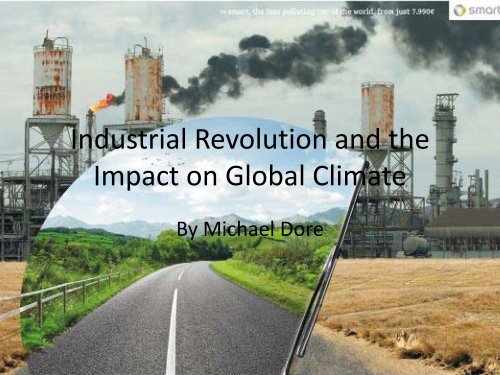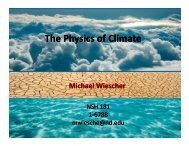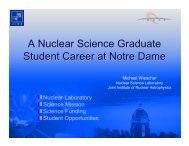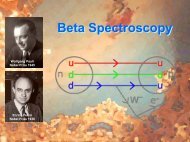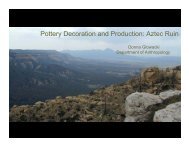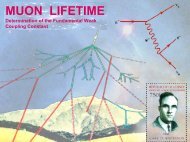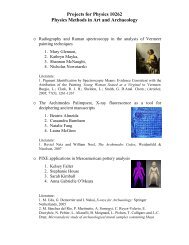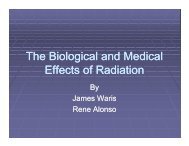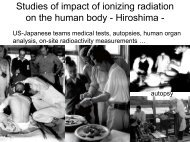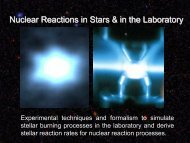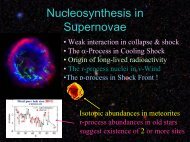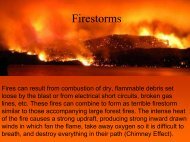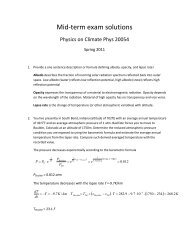Industrial Revolution and the Impact on Global Climate
Industrial Revolution and the Impact on Global Climate
Industrial Revolution and the Impact on Global Climate
You also want an ePaper? Increase the reach of your titles
YUMPU automatically turns print PDFs into web optimized ePapers that Google loves.
<str<strong>on</strong>g>Industrial</str<strong>on</strong>g> <str<strong>on</strong>g>Revoluti<strong>on</strong></str<strong>on</strong>g> <str<strong>on</strong>g>and</str<strong>on</strong>g> <str<strong>on</strong>g>the</str<strong>on</strong>g><br />
<str<strong>on</strong>g>Impact</str<strong>on</strong>g> <strong>on</strong> <strong>Global</strong> <strong>Climate</strong><br />
By Michael Dore
• 1859 Tyndall<br />
• 1896 Arrhenius<br />
• 1870-1910 Sec<strong>on</strong>d <str<strong>on</strong>g>Industrial</str<strong>on</strong>g><br />
<str<strong>on</strong>g>Revoluti<strong>on</strong></str<strong>on</strong>g>.<br />
• 1938 Callendar<br />
• 1956 Phillips <str<strong>on</strong>g>and</str<strong>on</strong>g> Plass<br />
• 1957 Revelle<br />
• 1960 Keeling<br />
• 1967 Manabe <str<strong>on</strong>g>and</str<strong>on</strong>g> We<str<strong>on</strong>g>the</str<strong>on</strong>g>rald<br />
• 1985 Villach c<strong>on</strong>ference<br />
• 1989 Fossil-fuel <str<strong>on</strong>g>and</str<strong>on</strong>g> o<str<strong>on</strong>g>the</str<strong>on</strong>g>r<br />
industries form <strong>Global</strong> <strong>Climate</strong><br />
Coaliti<strong>on</strong><br />
• 2001 Third IPCC report<br />
History
Industry<br />
• <str<strong>on</strong>g>Industrial</str<strong>on</strong>g> <str<strong>on</strong>g>Revoluti<strong>on</strong></str<strong>on</strong>g>- 18th to<br />
<str<strong>on</strong>g>the</str<strong>on</strong>g> 19th century<br />
• The largest source of CO2<br />
emissi<strong>on</strong>s globally is <str<strong>on</strong>g>the</str<strong>on</strong>g><br />
combusti<strong>on</strong> of fossil fuels such<br />
as coal, oil <str<strong>on</strong>g>and</str<strong>on</strong>g> gas in power<br />
plants, automobiles, industrial<br />
facilities <str<strong>on</strong>g>and</str<strong>on</strong>g> o<str<strong>on</strong>g>the</str<strong>on</strong>g>r sources.
Overview<br />
• The current warming trend is of particular<br />
significant<br />
• Greenhouse gases dem<strong>on</strong>strated in <str<strong>on</strong>g>the</str<strong>on</strong>g> mid-19th<br />
century.<br />
• Increased levels of greenhouse gases must cause<br />
<str<strong>on</strong>g>the</str<strong>on</strong>g> Earth to warm in resp<strong>on</strong>se.<br />
• Ice cores drawn from Greenl<str<strong>on</strong>g>and</str<strong>on</strong>g>, Antarctica, <str<strong>on</strong>g>and</str<strong>on</strong>g><br />
tropical mountain glaciers show that <str<strong>on</strong>g>the</str<strong>on</strong>g> Earth’s<br />
climate resp<strong>on</strong>ds to changes in solar output, in<br />
<str<strong>on</strong>g>the</str<strong>on</strong>g> Earth’s orbit, <str<strong>on</strong>g>and</str<strong>on</strong>g> in greenhouse gas levels.
Causes<br />
• Most climate scientists agree <str<strong>on</strong>g>the</str<strong>on</strong>g> main cause<br />
of <str<strong>on</strong>g>the</str<strong>on</strong>g> current global warming trend is human<br />
expansi<strong>on</strong> of <str<strong>on</strong>g>the</str<strong>on</strong>g> greenhouse effect.<br />
– water vapor<br />
– carb<strong>on</strong> dioxide<br />
– methane<br />
– nitrous oxide<br />
– chlorofluorocarb<strong>on</strong>s (CFCs)
• Burning of fossil fuels<br />
• The clearing of l<str<strong>on</strong>g>and</str<strong>on</strong>g><br />
• More than 90 percent probability that human<br />
activities over <str<strong>on</strong>g>the</str<strong>on</strong>g> past 250 years have<br />
warmed our planet.<br />
• Carb<strong>on</strong> dioxide levels have raised from 280<br />
parts per milli<strong>on</strong> to 379 parts per milli<strong>on</strong> in<br />
<str<strong>on</strong>g>the</str<strong>on</strong>g> last 150 years.
CO2 producti<strong>on</strong> by humans<br />
• 29 gigat<strong>on</strong>s of CO2 a year<br />
• Atmospheric CO2 is at its highest<br />
level in 15 to 20 milli<strong>on</strong> years<br />
• A natural change of 100ppm<br />
normally takes 5,000 to 20,000<br />
years. The recent increase of<br />
100ppm has taken just 120 years.<br />
• Atmospheric c<strong>on</strong>centrati<strong>on</strong> of CO2<br />
has increased by 35% since <str<strong>on</strong>g>the</str<strong>on</strong>g><br />
beginning of <str<strong>on</strong>g>the</str<strong>on</strong>g> age of<br />
industrializati<strong>on</strong>.
The Possible C<strong>on</strong>sequences<br />
• Hotter<br />
• More Precipitati<strong>on</strong><br />
• Higher Sea Level<br />
• Shifting climate pattern
Carb<strong>on</strong> Dioxide C<strong>on</strong>centrati<strong>on</strong>
Sea Level
<strong>Global</strong> Surface Temperature
Arctic Sea Ice
What can we do?<br />
• Individual resp<strong>on</strong>ses<br />
• Nuclear energy<br />
• O<str<strong>on</strong>g>the</str<strong>on</strong>g>r carb<strong>on</strong> free energy sources<br />
– solar power<br />
– wind power<br />
– hydrokinetics<br />
• Switching from high-carb<strong>on</strong> fuels like coal <str<strong>on</strong>g>and</str<strong>on</strong>g> oil, to reducedcarb<strong>on</strong><br />
fuels<br />
– natural gas<br />
• Carb<strong>on</strong> sequestrati<strong>on</strong><br />
– Geologic sequestrati<strong>on</strong><br />
• In my opini<strong>on</strong> <str<strong>on</strong>g>the</str<strong>on</strong>g> best opti<strong>on</strong> is for a combinati<strong>on</strong> of all of <str<strong>on</strong>g>the</str<strong>on</strong>g>se
Recap<br />
• Industry has made <str<strong>on</strong>g>the</str<strong>on</strong>g> st<str<strong>on</strong>g>and</str<strong>on</strong>g>ard of living significantly higher but it<br />
has come at a cost that we are now seeing.<br />
• Because with <str<strong>on</strong>g>the</str<strong>on</strong>g> industrial revoluti<strong>on</strong> brought about a significant<br />
amount of burning fossil fuels for energy.<br />
• The burning of a hydrocarb<strong>on</strong> (fossil fuel) produces carb<strong>on</strong> dioxide.<br />
• This carb<strong>on</strong> dioxide producti<strong>on</strong> has become so significant that it has<br />
led to increased temperatures, higher sea levels, <str<strong>on</strong>g>and</str<strong>on</strong>g> decreasing ice<br />
amounts.<br />
• If we as a society do not start making some changes it seems as if<br />
<str<strong>on</strong>g>the</str<strong>on</strong>g> problem will <strong>on</strong>ly c<strong>on</strong>tinue to persist <str<strong>on</strong>g>and</str<strong>on</strong>g> worsen.<br />
• While <str<strong>on</strong>g>the</str<strong>on</strong>g>re are some opti<strong>on</strong>s to help reduce carb<strong>on</strong> dioxide<br />
emissi<strong>on</strong>s such as carb<strong>on</strong> free energy sources, using more reducedcarb<strong>on</strong><br />
fuels, <str<strong>on</strong>g>and</str<strong>on</strong>g> carb<strong>on</strong> sequestrati<strong>on</strong> it seems <str<strong>on</strong>g>the</str<strong>on</strong>g> best opti<strong>on</strong><br />
would to be to use a combinati<strong>on</strong> of <str<strong>on</strong>g>the</str<strong>on</strong>g>se while more technology is<br />
developed.
Sources<br />
• C<strong>on</strong>way EM. Atmospheric Science at NASA: A History Baltimore, MD: Johns Hopkins University<br />
Press, 2008.<br />
• Fleming JR, ed. Classic Papers <strong>on</strong> <strong>Global</strong> Warming Online (PALE). 2008. At<br />
http://wiki.nsdl.org/index. php/PALE:ClassicArticles/<strong>Global</strong>Warming.<br />
• IPCC Fourth Assessment Report, Summary for Policymakers.<br />
• Le Treut H, Somerville R, Cubasch U, Ding Y, Mauritzen C, et al. Historical overview of climate<br />
change science. In: Solom<strong>on</strong> S, Qin D, Manning M, Chen Z, Marquis M, et al. eds. <strong>Climate</strong> Change<br />
2007. The Physical Basis of <strong>Climate</strong> Change. C<strong>on</strong>tributi<strong>on</strong> of Working Group I to <str<strong>on</strong>g>the</str<strong>on</strong>g> Fourth<br />
Assessment Report of <str<strong>on</strong>g>the</str<strong>on</strong>g> IPCC. Cambridge <str<strong>on</strong>g>and</str<strong>on</strong>g> New York: Cambridge University Press; 2007, 93–<br />
127. Online at http://www.ipcc.ch/<br />
• T.C. Peters<strong>on</strong> et.al., "State of <str<strong>on</strong>g>the</str<strong>on</strong>g> <strong>Climate</strong> in 2008," Special Supplement to <str<strong>on</strong>g>the</str<strong>on</strong>g> Bulletin of <str<strong>on</strong>g>the</str<strong>on</strong>g><br />
American Meteorological Society, v. 90, no. 8, August 2009, pp. S17-S18<br />
• V. Ramaswamy et.al., “Anthropogenic <str<strong>on</strong>g>and</str<strong>on</strong>g> Natural Influences in <str<strong>on</strong>g>the</str<strong>on</strong>g> Evoluti<strong>on</strong> of Lower<br />
Stratospheric Cooling,” Science 311 (24 February 2006), 1138-1141<br />
• Weart SR The Discovery of <strong>Global</strong> Warming, 2nd ed. Cambridge: Harvard University Press; 2008<br />
• Weart SR. The Discovery of <strong>Global</strong> Warming, revised editi<strong>on</strong>. 2008. At<br />
http://www.aip.org/history/climate<br />
• Weart SR. The Idea of Anthropogenic global climate change in <str<strong>on</strong>g>the</str<strong>on</strong>g> 20 th century. WIREs Clim Change<br />
2010 1 67–81.


